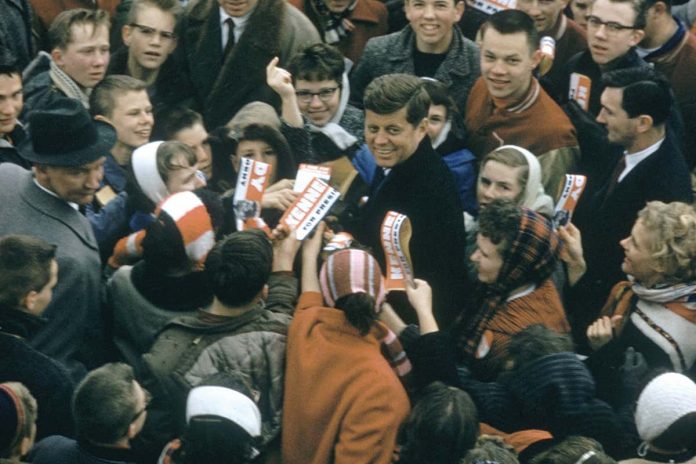[ad_1]

Stan Wayman/The Life Picture Collection Via Getty Images
IN SEPTEMBER 2016, Alexander Nix, CEO of Cambridge Analytica, told an audience in New York about the power of big data in global elections. Know the personality of the people you target, and “you can nuance your messaging to resonate more effectively” with them, he said.
That London-based political consultancy was behind the Brexit Leave campaign. And it offered the Trump team a model to predict the personality of individual voters in the 2016 US election.
Another shiny product of 21st-century data science? No. As early as 1960, a US firm used prediction analytics to help elect a president. In If Then, Harvard historian Jill Lepore tells that riveting story.
In 1959, Simulmatics was set up in New York. It was to lay the foundations of a world in which algorithms attempt to forecast and influence our every move by simulating our very selves.
Simulmatics founder Ed Greenfield brought in behavioural scientists, technologists, pollsters and statisticians. The idea: collect enough data on enough people, feed it into a machine and everything will be predictable. Minds will be simulated, acts anticipated, and even driven, by targeted messages.
The scientists compiled data from election returns and public opinion surveys going back to 1952. Then they built a computer simulation of the 1960 election on which to test scenarios about an endlessly customisable population. Using the if/then formula of computer language Fortran, they could model any move a candidate might make and track voter response down to the tiniest segment of the electorate.
Dubbed the “People Machine”, this simulation predicted that to win, John F. Kennedy needed the black vote. He took a strong position on civil rights. It also advised him to confront religious prejudice and win minority support by being upfront about his own Catholicism.
Today, Kennedy’s victory might look like a forgone conclusion, but his telegenic personality and charisma alone didn’t carry the race. His team denied getting help from any “electronic brain”, but Simulmatics’s reports are in the archives at the John F. Kennedy Presidential Library and Museum, Lepore writes.
After the elections, Simulmatics took on new projects, but was limited by 1960s technology. In 1970, it declared bankruptcy. It lives on in science fiction novel Simulacron-3 and film adaptation World on a Wire, itself a forerunner of 1999 cult classic The Matrix.
By the 21st century, information about individuals was abundant, accessible and easier to process with faster computers. Social media connected millions, then billions – all exchanging messages guided by algorithms designed to inform, entertain and manipulate.
Its sheer power helped those early dreams to grow and prosper in unimaginable ways. In The Hype Machine, Sinan Aral at the Massachusetts Institute of Technology examines the science behind this disruptive power. He outlines his own research into Twitter, which has shown how fake news penetrates further and faster than accurate information. The more shocking, salacious and emotionally arousing (especially fake political news), the more we are moved to spread it.
In 2014, Russia’s Internet Research Agency set up accounts on platforms including Facebook and Twitter to sway US voters with fake news. This was “one of the most comprehensive weaponizations of misinformation the world has ever seen”, says Aral.
But it still had to target the right misinformation at the right voters. Cambridge Analytica’s model, built using Facebook data, helped to predict voter personality. Russian fake news targeted voters in swing states with customised messages. Supporters of Black Lives Matter, for example, saw memes that encouraged them not to vote, while other messaging persuaded right-leaning voters to turn out.
Did Russian interference really flip the US election against Hillary Clinton in 2016? We need more research, says Aral. As for the upcoming 2020 US election, last month, Facebook took down a small network of fake accounts linked to Russian operatives. This was no surprise. Intelligence officials had warned that Russia has adopted less detectable tactics. And Facebook founder Mark Zuckerberg’s recent blog on the company’s election-related policies has left Aral thinking the company has not done enough to make the 2020 elections safe.
“Fake news penetrates further and faster than accurate information on Twitter”
To stave off the threat of digital manipulation, we need to understand it and legislate to neutralise it, writes Aral. The US lacks even a basic federal law to protect consumer data. The question of how to maintain privacy while feeding more data to machines emerged in the 1960s with the People Machine, but a big opportunity to do something was missed, says Lepore.
If Then and The Hype Machine are both eminently relevant now. Lepore’s page-turner about a forgotten chapter of US history resonates today, and Aral’s nuanced, slower read offers hope that we can re-engineer social media to better serve society.
The books’ biggest service, however, is to make us rethink our attitudes to big data and social media. This can only be good: after all, it is still humans who cast the votes, not machines.
More on these topics:
[ad_2]
Source link











